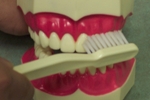If you are continually eating sweets all day long because candy or other sugary treats are available, it raises the acid levels in your mouth to a higher than normal level and that can lead to an increase in demineralization of the enamel and cavity formation.
Also, the sticky nature of most candy provides the bacteria with more opportunity to create the acid that causes all the problems. And, it goes without saying that sticky candies and sweets are not the best thing to be eating if you have crowns, bridges or other prosthetic appliances in your mouth that can be ‘pulled’ out.”Does that mean you shouldn’t have any sweets during the holidays? No, sweets in moderation are fine. The real issue stems back to people’s brushing habits in general.
The simple fact is most people do not know how to properly brush their teeth, both from a technique standpoint, length of time and frequency. After selecting a good toothbrush and toothpaste (Dr. Wolfert recommends a soft brush and any toothpaste with fluoride), a good brushing should take at least two minutes and as many four. While there are many different techniques for brushing, here is one of the more popular ways:
- Hold the brush on two to three teeth with a 45 degree angle on the teeth and under the gum. Gently press against the gum so the tips of the bristles go in between the gum and the teeth.
- Apply lateral pressure, making the motion of little circles with the final stroke away from under the gums in order to sweep the plaque away from the teeth and the gum.
- Repeat this motion six to 10 times and move on to the next area of two to three teeth. If your mouth is full of foam, rinse out with water and continue brushing. Your brushing is completed when you have brushed all the surfaces of your teeth; the front, backs and tops of all teeth.
 As far as frequency of brushing is concerned, ideally you want to brush your teeth after each meal. This isn’t always easy to do if you’re out at a party or gathering during the holidays. If you can’t brush right after you eat, you should, at the very least, brush thoroughly twice a day, after breakfast and before going to bed.
As far as frequency of brushing is concerned, ideally you want to brush your teeth after each meal. This isn’t always easy to do if you’re out at a party or gathering during the holidays. If you can’t brush right after you eat, you should, at the very least, brush thoroughly twice a day, after breakfast and before going to bed. The holidays are not a good time to get a toothache, with many dentists spending time with THEIR families. Often times you will have to be treated by a covering dentist who doesn’t know your dental issues as well as your primary dentist. Therefore, a checkup prior to the holidays is a very good idea. That way if there are any existing problems, you can address them before you start eating those rich desserts and sweets at the holidays that can aggravate an existing condition.
We have more information and diagrams illustrating proper brushing technique on our website.
